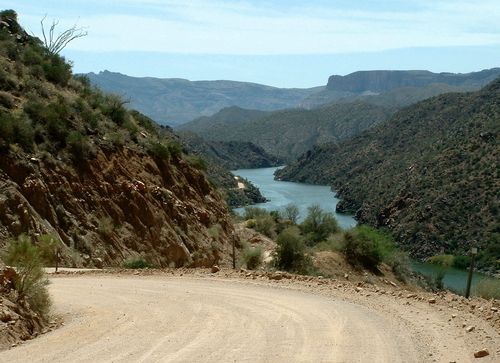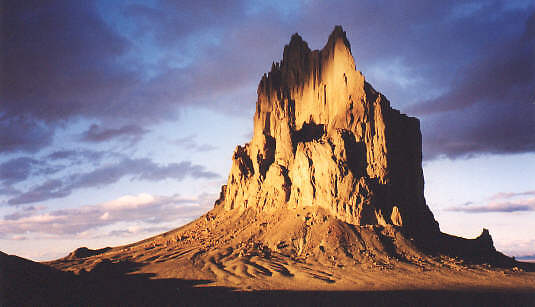
My Backcountry Adventures
 |
Highway 88 (Apache Trail), Arizona
Looking back on my numerous desert trips, I remember a couple of incidents which made some impression on me and taught me to be cautious:
Somewhere in the desert between Cathedral Valley and Goblin Valley (Utah), I got stuck in loose sand.
Since there was no help in sight, I had to dig the car up with my bare hands (you should have seen
my fingers afterwards). With the aid of the jack and a number of rocks that I gathered, I finally got
the car going again. That day, I decided to buy a collapsible spade (which I had to use repeatedly
since then).
On another occasion, I drove down a narrow and winding dirt road (Long Canyon Rd) near Canyonlands
National Park, Utah. After a steep grade followed by a sharp curve, the road suddenly became impassable
because it was strewn with rocks and had deep holes. I reversed because the road had only one lane and
was too narrow to turn the car (on the right side of the road was a perpendicular wall of rock, on the
left side was an abyss of several hundred feet). Now the road surface turned out to be too slippery to
drive uphill again because there was some snow and mud left from the day before. I was trapped. I had
no other choice than going downhill again and repairing the road as best I could. So I stopped every
few yards, got the biggest chunks of rock out of the way, and collected smaller rocks and pebbles to
fill the deepest holes. It took about two hours until the worst was over and I reached a point where
the road became tolerable again. This is how I learned to appreciate high-clearance 4WD vehicles.
During a drive through Pine Ridge Indian Reservation in South Dakota, the weather got worse, and it
started drizzling. I kept driving until I noticed that the dirt road became slippery. According to
the map, the next paved road was still many miles away. Therefore, I decided to go back, and turned
the car. Meanwhile, the drizzle had become heavy rain. On the way back, the road surface (probably
clay) became so slippery that steering the car was almost impossible, even at slow speed.
I saw a 4WD truck whose lower half stuck in a clay road which had obviously turned into an almost
bottomless mudhole during a previous storm. Meanwhile, the mud had dried again and had become as
hard as concrete. I still wonder how the owner finally got his truck back (probably with the aid
of a pneumatic hammer).
One of my early GPS receivers suddenly quit working during a hike in White Sands National Monument,
New Mexico. Luckily, I found the park road using my compass. When I took the GPS apart later, I found
a defective solder joint.
During a hike in the Red Rock area south of Flagstaff, Arizona, I stumbled and fell into a Prickly Pear
cactus (damned thing stood right in my way). When I got up, I saw a needle protruding from my knee. I
pulled it out, and was amazed to see it was almost 2 inches long. Since I didn't feel much pain, I went
on and forgot about it. When I woke up the next morning, however, my knee had assumed the size of a
water melon, and my leg was so stiff I could barely walk. I thought the vacation was over, but the knee
got better after a few days, and I didn't have to see a doctor.
On another trip, I felt a sudden, violent pain in my leg when I stepped back to take a photo of something.
I first thought a rattlesnake had bitten me. Then I realized that I had run into a Cholla Cactus (I seem
to attract cactuses somehow). Dozens of spines had penetrated my pants and stuck in my right calf. Ridding
myself of the cactus and removing the spines proved to be a painful procedure since a Cholla Cactus has
barbed spines. A few hours later, a huge and almost black bruise occured where all the spines had been.
Luckily, I didn't get an infection.
My wife almost stepped on a snake when we strolled through the desert east of Capitol Reef NP, Utah.
Fortunately, the animal, which was about 5 ft long, showed no aggressive behaviour (see photo). On
closer examination, it proved to be a (non-poisonous) gopher snake. We observed it for several minutes
until it disappeared under a rock. I'm still glad it was no rattlesnake. Getting bitten by a diamondback
is probably no fun when you are in the middle of nowhere and far from any medical help.
 |
Tick bites are not only unpleasant but also bear the risk of catching dangerous diseases. I got bitten
repeatedly during a hike in Rocky Mountain NP. I removed the ticks with tweezers and had blood samples
taken by my doctor after returning home. Luckily, no bugs were found. I know a woman, however, who
developed a chronic heart disease after a tick bite and later needed a pacemaker. The risk of bites and
associated infections is significantly reduced when using a strong insect repellent like diethyltoluamide.
I have never observed flash floods, but I saw what they can do. Flash floods are torrents of water and mud
suddenly occurring during or after rainstorms. They can carry all kinds of debris like rocks and uprooted
trees, and destroy almost anything in their path. Flash floods are particularly dangerous in narrow ravines
and canyons since they may gain considerable height and speed there. Ironically, more people are killed by
flash floods in the desert than by dehydration. If you hear or see signs of an approaching flash flood,
climb for safety! A car does not provide sufficient shelter.
 |
Shiprock Peak, New Mexico
